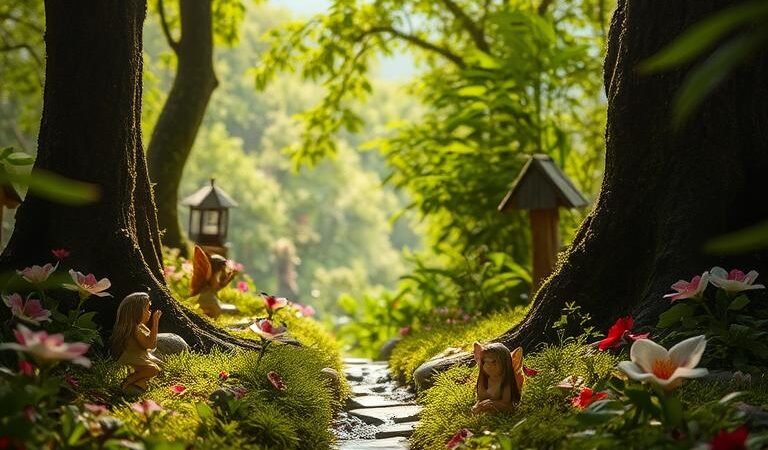Creating a fairy garden is a delightful way to transform your outdoor space into a magical retreat. I’ve always been enchanted by the idea of miniature landscapes, and my journey into fairy gardening has become a cherished hobby that brings joy and whimsy to my yard.
Fairy gardens combine the art of miniature gardening with creative storytelling, offering endless possibilities in design and themes. This hobby not only provides a therapeutic escape from stress but also encourages outdoor time for both adults and children. Whether you have a large outdoor area or a small balcony, you can create your own fairy garden and enjoy the many benefits it has to offer.
Key Takeaways
- Create a whimsical outdoor space with a fairy garden
- Combine miniature gardening with creative storytelling
- Enjoy therapeutic benefits, including stress relief and outdoor time
- Customize your fairy garden to fit any space, large or small
- Explore various design and theme possibilities
- Make it a fun and creative activity for the whole family
The Magic of Fairy Gardens
The enchanting world of fairy gardens is a place where imagination knows no bounds. Creating a fairy garden is a delightful project that can bring joy to people of all ages. As I’ve observed, fairy gardens have been a way to get kids outside, entertain them, and keep them busy during summer break.
Fairy gardens have evolved over time, and their magic has captivated many. They make people smile and remind them of their children when they were younger. People have made many versions that they have given as gifts to friends and families.
What Are Fairy Gardens?
Fairy gardens are miniature gardens that are designed to attract fairies or simply to create a whimsical outdoor space. They often feature small plants, decorative accessories, and intricate designs. A fairy garden can be a wonderful way to express your creativity and connect with nature.
Why Create a Fairy Garden?
Creating a fairy garden can have numerous benefits, including stress relief, creative expression, and a deeper connection with nature. Some of the benefits of fairy gardening include:
- Teaching children about plants, creativity, and storytelling
- Serving as conversation starters and unique decorative elements for homes and gardens
- Providing a meditative and therapeutic experience
- Allowing for personalization to reflect individual interests
- Evolving over time, enabling continuous creativity and adaptation
As you embark on creating your own fairy garden, you’ll discover the joy and magic that comes with it. With a little imagination and creativity, you can craft a whimsical outdoor escape that brings happiness to all who experience it.
Essential Materials for Your Fairy Garden DIY
The magic of a fairy garden begins with the right materials and a little creativity. To create a whimsical outdoor escape, you’ll need to gather some essential supplies.
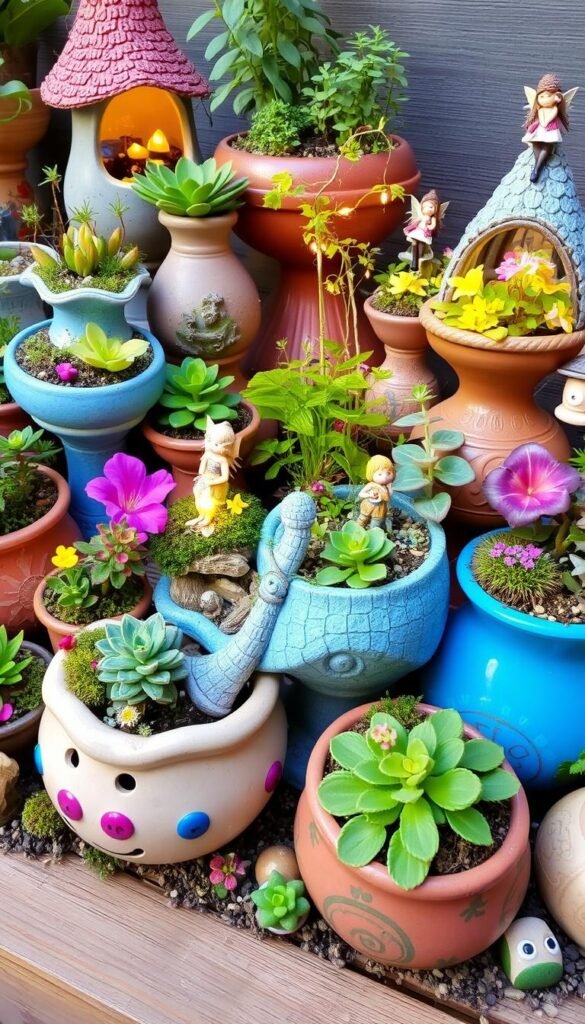
Containers and Vessels
The container is the foundation of your fairy garden. You can use pots of any size, from shallow to deep, or even nested pots of different sizes. Broken pots, bowls, or tea cups with drainage holes can also make charming containers. Consider using a container that complements the theme of your fairy garden.
Soil and Landscaping Materials
The type of soil you need depends on the plants you’ve chosen. For succulents, use succulent-cactus soil, while regular potting soil works well for other plants. You can also add stones, rocks, and sand to create pathways, accents, or structural elements. These materials will help bring your fairy garden to life.
Tools You’ll Need
To create and maintain your fairy garden, you’ll need some basic tools. A small hand shovel, mini shovel, pruning shears, and long tongs are essential for planting and caring for your miniature plants. You can also repurpose tools from other hobbies, like terrarium-making or kitchen utensils. Specialized tools, such as precision tweezers, can be helpful for detailed work.
Choosing the Perfect Plants
The key to a magical fairy garden lies in choosing the perfect plants. Plant selection depends on climate, sun exposure, and availability, making it essential to pick flora that thrive in your local conditions.
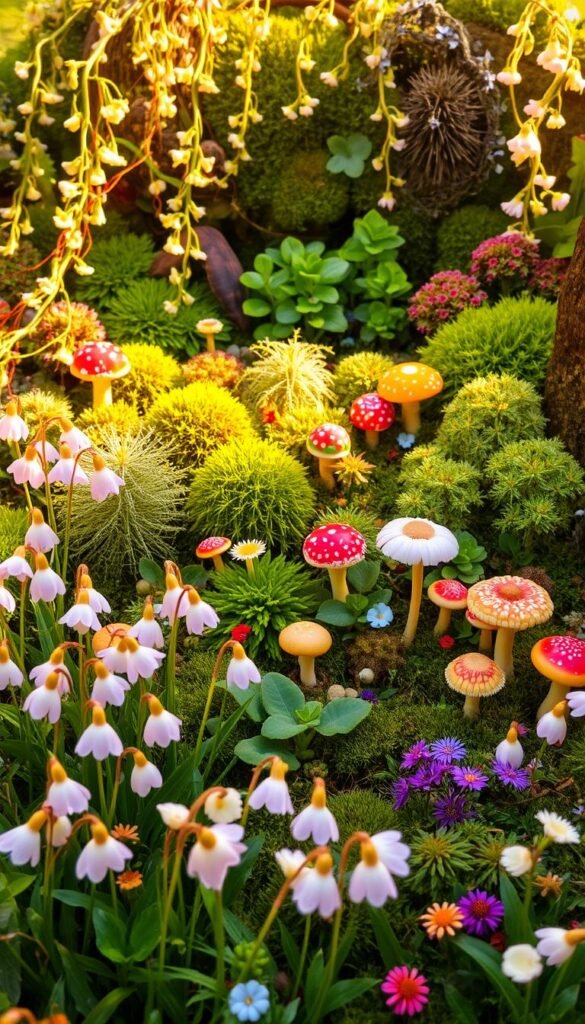
Succulents for Dry Climates
For arid climates like San Diego, succulents are an excellent choice. Varieties such as Hens and chicks, Trailing succulents (string of pearls, donkey tail), Ice plant, Echeveria, Sempervivum, and Sedum (coral carpet, black pearl) work well. These plants come in various sizes and are perfect for creating a miniature landscape that is both beautiful and low-maintenance.
Moisture-Loving Plants
If your fairy garden is in a more humid climate or you prefer plants that love moisture, consider Irish moss, Scotch moss, Creeping thyme, and Baby tears. These plants are ideal for creating lush, vibrant environments and can thrive in shaded or partially shaded areas.
Ground Covers and Mosses
Ground covers and mosses are crucial for creating the perfect miniature “lawns” for your garden. They help establish scale and create the illusion of expansive green spaces. Varieties like Kurapia, Micro clover, and Super star creeper are excellent choices. They maintain their miniature size with minimal maintenance and can be used to define different “zones” within your fairy garden landscape.
By combining these ground covers with other plants, you can create naturalistic miniature landscapes that are both enchanting and easy to care for. Remember, all plants grow, so regular pruning and tending are required to keep your fairy garden looking its best.
Planning Your Fairy Garden Layout
Creating a fairy garden that enchants requires a thoughtful approach to its design and layout. A well-designed fairy garden can transport you to a magical world, right in your own backyard.
Single-Level vs. Multi-Level Designs
When planning your fairy garden, one of the first decisions you’ll need to make is whether to go for a single-level or multi-level design. A single-level design is simpler and can be very effective for small containers, while a multi-level design can add depth and visual interest to your garden.
Creating Zones in Your Garden
To enhance the story and visual appeal of your fairy garden, consider creating distinct “zones” or areas within it. These zones can be defined using plants, pathways, and accessories, and can include living areas, work spaces, recreational areas, and wild spaces. For example, you could have a gardening area with miniature tools and plants, a dining space with a tiny table and chairs, or a relaxation spot with a miniature bench.
| Zone Type | Description | Example Elements |
|---|---|---|
| Living Area | A cozy space for fairies to rest | Miniature furniture, soft plants |
| Work Space | An area for fairies to work or create | Miniature tools, craft supplies |
| Recreational Area | A space for fairies to play or exercise | Miniature play equipment, pathways |
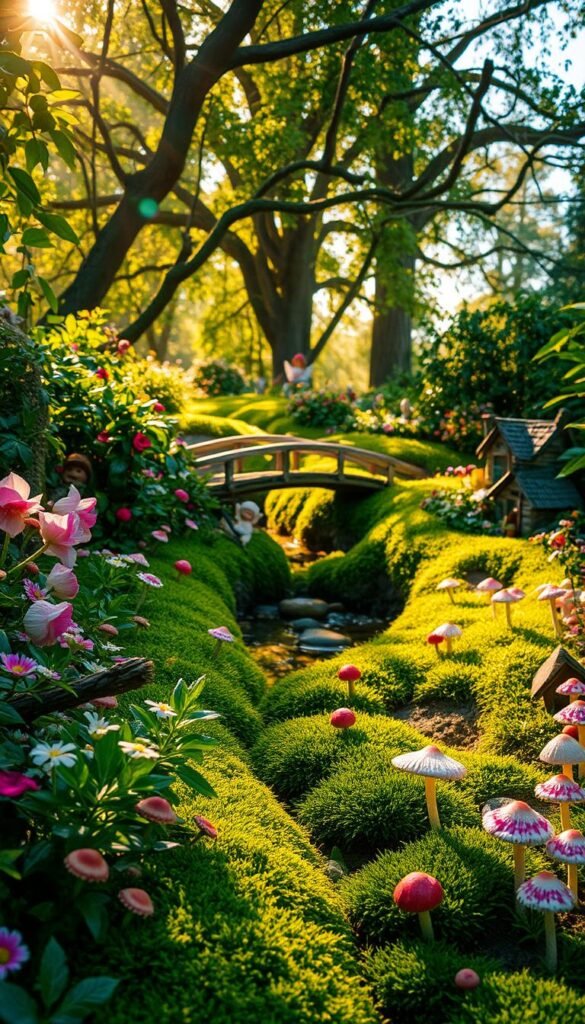
By creating these zones, you can organize your fairy garden and make it more engaging for viewers. The key is to use your imagination and have fun with the design process!
Step-by-Step Fairy Garden DIY Guide
In this guide, I’ll walk you through the process of creating a beautiful fairy garden, step by step. With a little patience and creativity, you can craft a whimsical outdoor escape that will delight both children and adults alike.
Preparing Your Container
The first step in creating your fairy garden is to prepare the container. Choose a container that is well-draining and has good aeration for the roots of your plants. If you’re using a container that doesn’t have drainage holes, consider drilling some to prevent waterlogged soil.
For a multi-level garden, you’ll need to add supports to create different layers. You can use broken pot pieces or river rocks secured with clay-heavy dirt to create these levels.
Adding Soil and Support Structures
Fill your container with well-draining soil that will hold its structure. If you’re creating a multi-level garden, add your supports as described earlier. You can also add stairs made from flat river rocks to connect the different levels.
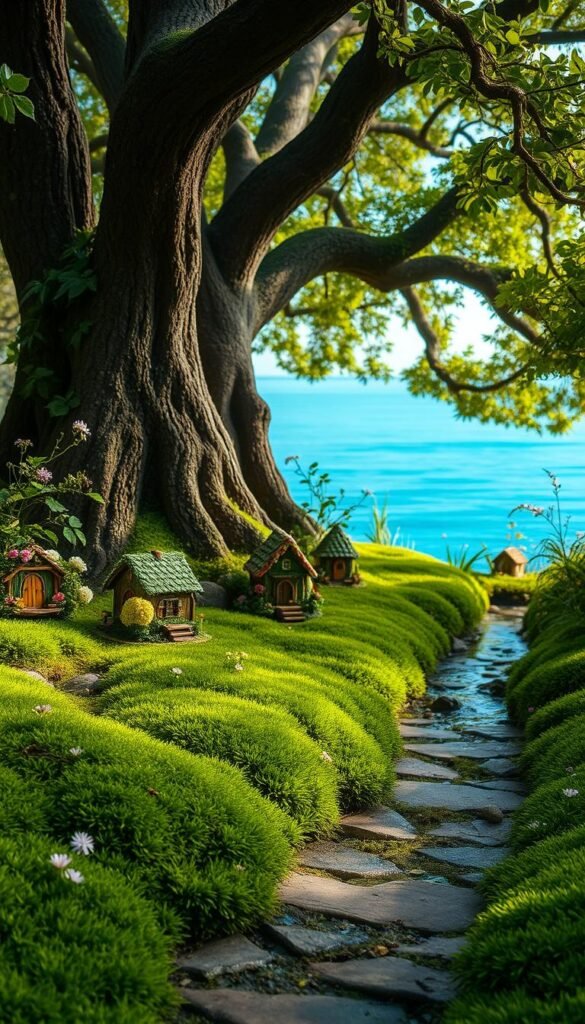
Planting Your Miniature Garden
Now it’s time to add the plants to your fairy garden. Choose plants that are suitable for your climate and the level of maintenance you’re willing to provide. For dry climates, succulents are an excellent choice, while Irish moss is perfect for creating lush, green slopes that require more moisture.
When planting, consider the mature size of the plants and leave enough space for them to grow. You can also create pathways using coarse sand, pouring it around the plants and smoothing it to the edge.
Finally, add some finishing touches to your fairy garden, such as rocks among the plants for interest, or river rocks and sea glass to create a water feature. You can also add miniature furniture, animals, or structures to bring your garden to life.
As “The magic of a fairy garden lies in its ability to transport us to a world of wonder and enchantment.” By following these steps, you can create a beautiful and thriving fairy garden that will be a joy to behold.
Crafting Pathways and Landscapes
Crafting a whimsical fairy garden involves more than just planting miniature flora; it requires creating an immersive landscape that captivates the imagination. The pathways and terrain features in your fairy garden play a crucial role in guiding visitors through this miniature world.
Stone and Pebble Pathways
One of the simplest ways to add visual interest to your fairy garden is by creating pathways using stones or pebbles. These materials come in various colors and textures, allowing you to choose the perfect fit for your garden’s theme. To create a stable pathway, start by laying down a layer of small rocks or pebbles, followed by a few larger stones to serve as stepping stones.
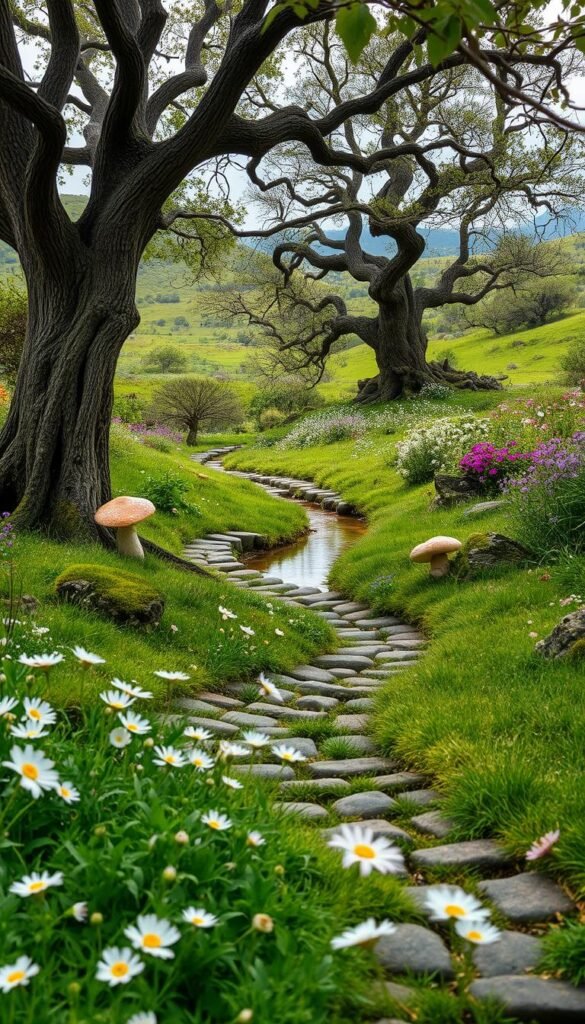
Creating Hills and Valleys
To add depth and visual interest to your fairy garden, consider creating hills and valleys. You can achieve this by sculpting soil mounds, using foam blocks, or stacking stones. Cover these structural elements with moss, plants, or ground covers to create a natural-looking terrain. Varying the topography of your fairy garden not only adds visual appeal but also creates separate “rooms” or areas within the landscape.
- Use soil mounds or foam blocks to create elevations.
- Cover structural elements with moss or plants.
- Ensure proper drainage to prevent soil erosion.
DIY Fairy Houses and Structures
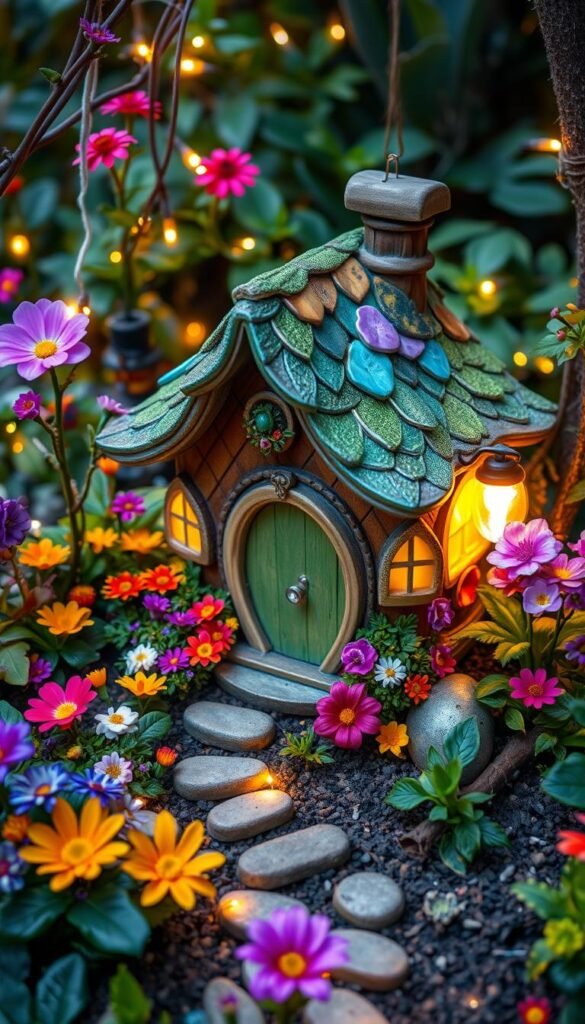
Building a DIY fairy house is a fun and creative project that can be customized to fit your garden’s theme. When it comes to creating fairy houses, the materials you choose are crucial for durability and aesthetic appeal. You can use a variety of materials, including wood, popsicle sticks, metal, and resin, each with its own advantages and disadvantages.
For instance, wood, especially when painted with acrylics, holds up well over time, making it a great choice for fairy houses. Thicker pieces of wood are particularly durable. On the other hand, popsicle sticks, while fun for temporary structures, tend to warp easily due to weather changes. Metal can corrode over time, so it’s not the most ideal material. Store-bought resin accessories, however, last surprisingly well, although their colors may fade in sunlight.
Popsicle Stick Fairy Houses
Popsicle stick fairy houses are a fun and easy project, perfect for a temporary or seasonal addition to your fairy garden. To create one, you’ll need popsicle sticks, glue, and some decorative items like paint or glitter. Use waterproof glue instead of hot glue, which tends to fall apart over time. You can also incorporate twine for added detail.
Natural Material Houses
Using natural materials like twigs, leaves, and rocks can create a fairy house that blends seamlessly into your garden. These materials are readily available and can be arranged to create a charming, rustic home for your fairies. Painted rocks can be used to add decorative elements that last several years even without sealing.
Upcycled Container Cottages
Transforming everyday containers into fairy cottages is a creative way to add personality to your fairy garden. Items like teapots, birdhouses, flower pots, and even tin cans can be modified to create unique fairy dwellings. The key is to disguise the original purpose of these items to enhance the magical illusion. You can also combine upcycled items with natural materials for a more authentic look.
By incorporating these DIY fairy houses into your fairy garden, you can create a whimsical and enchanting atmosphere that invites imagination and wonder. Whether you choose popsicle sticks, natural materials, or upcycled containers, your fairy house is sure to be a delightful addition to your garden.
21 Handmade Fairy Garden Accessories
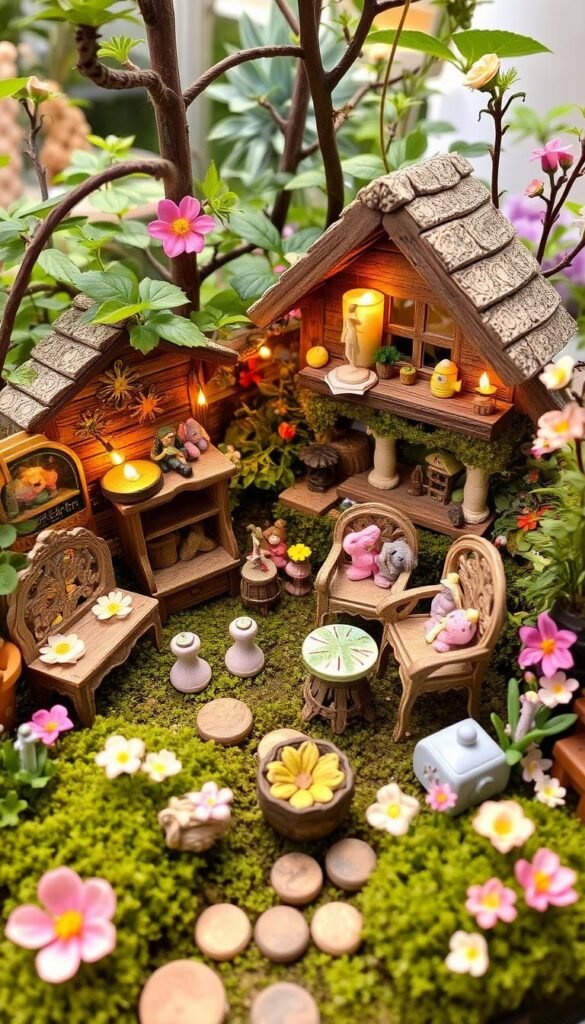
As we dive into the world of fairy garden accessories, you’ll discover a realm of creativity and imagination. Making your own DIY fairy garden accessories can be a fun and rewarding experience, allowing you to add a personal touch to your miniature landscape.
Furniture and Decorations
You can create a variety of furniture and decorations for your fairy garden using natural and found materials. For instance, you can make a polymer clay ladder that’s not only easy to work with but also safe for kids and durable when baked. Imagine a tiny fairy climbing up the ladder to reach their cozy little home!
Other ideas include crafting tiny flowerpots from store-bought miniature pots or using nutshells, rocks, or wood to create unique planters. You can also make polymer clay mushrooms and succulents to add a touch of whimsy to your garden.
Garden Tools and Equipment
Miniature gardening tools can be made from aluminum cans, adding a realistic touch to your fairy garden. You can also create miniature vegetables from polymer clay to give the impression that the fairies are tending to their own little garden.
Whimsical Elements
To add a touch of magic to your fairy garden, consider incorporating whimsical elements like a fairy tire swing made from doll tires or small tires from remote-control cars. You can also create a wishing well or an arbor using popsicle sticks, wooden twigs, or small vines.
Other ideas include making a bottle cap chairs and table set, a fairy barbecue, or a polymer clay lantern. You can also create a mirror pond or a hot glue waterfall to add a sense of movement and tranquility to your garden.
By incorporating these handmade accessories into your fairy garden, you’ll create a unique and enchanting miniature world that will transport you to a realm of wonder and magic.
Creating Water Features
A well-designed water feature can be the centerpiece of your fairy garden, adding a sense of calm and wonder. Water features can range from simple, static designs to more complex, flowing systems.
Mirror Ponds and Lakes
For a low-maintenance option, consider creating a mirror pond or lake effect using river rocks, blue and clear sea glass, and marbles. This gives the illusion of water without the need for actual water, eliminating concerns about mosquitos or algae. You can also use clear silicone, resin, or Mod Podge to create a reflective surface that mimics the appearance of water.
DIY Waterfalls and Streams
To create a more dynamic water feature, you can design a DIY waterfall or stream. Use stones, pebbles, and sand to create a natural-looking bed. For a more realistic effect, you can incorporate small pumps to circulate water, ideal for indoor or protected outdoor gardens. Enhance your water feature with appropriate plantings and accessories like tiny bridges or stepping stones to create a cohesive fairy garden landscape.
| Water Feature Type | Maintenance Level | Visual Impact |
|---|---|---|
| Mirror Pond | Low | High |
| Flowing Stream | Medium | Very High |
| Static Waterfall | Low | High |
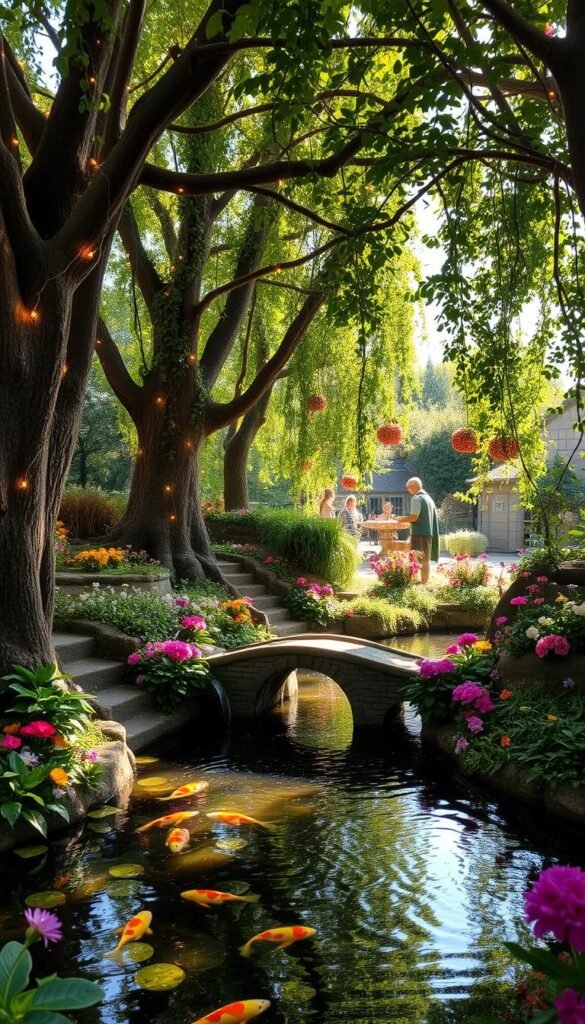
Themed Fairy Garden Ideas
Themed fairy gardens offer a unique way to express your creativity and connect with nature. By incorporating different themes, you can create a captivating outdoor space that reflects your personality and style. I will explore various themed fairy garden ideas, from beach and coastal gardens to woodland retreats and seasonal displays.
Beach and Coastal Gardens
Create a seaside-inspired fairy garden with shells, driftwood, and other coastal elements. Use plants like succulents and beach grasses to complement the theme. You can also add miniature beach furniture and accessories to enhance the ambiance.
Woodland Fairy Retreats
Transport yourself to a whimsical woodland with a fairy garden featuring moss, ferns, and native woodland plants. Incorporate natural elements like pinecones and acorns to create a cozy atmosphere. You can also add twinkling lights to mimic the dappled light of the forest.
Seasonal Fairy Gardens
Design a fairy garden that celebrates the changing seasons. Use plants and accessories that reflect the current season, such as miniature pumpkins in fall or Christmas trees in winter. This theme allows you to update your garden regularly, keeping it fresh and exciting throughout the year. Consider incorporating seasonal elements like Easter eggs or summer picnic scenes to add variety.
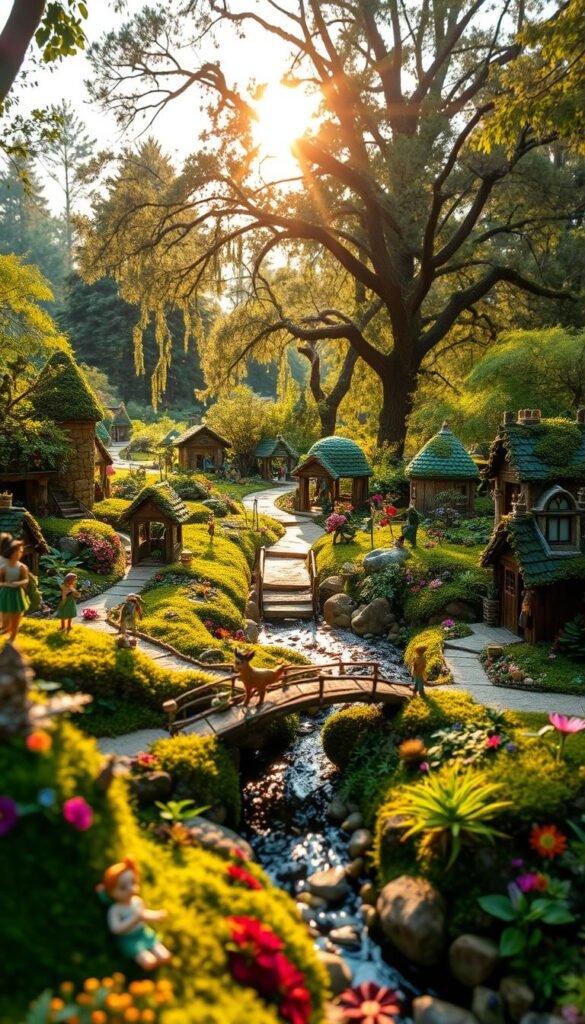
By exploring different themed fairy garden ideas, you can create a unique and enchanting outdoor space that showcases your creativity and connects you with nature.
Adding Fairy Garden Lighting
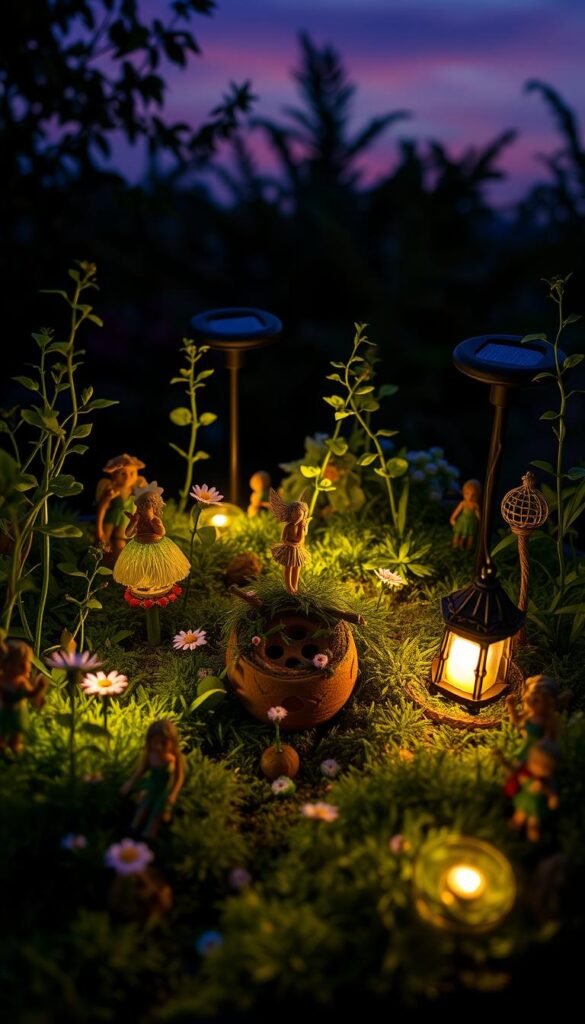
As the sun sets, your fairy garden can transform into a magical oasis with the right lighting. I will guide you through the process of creating a captivating ambiance in your miniature world. Fairy garden lighting is an essential element to consider, as it can elevate the overall aesthetic and make your garden even more inviting.
Solar-Powered Options
Solar-powered lights are an excellent choice for fairy gardens, as they are eco-friendly and require minimal maintenance. I recommend using solar-powered lights that are specifically designed for outdoor use, as they can withstand various weather conditions. These lights can be placed along pathways or around plants to create a warm and welcoming ambiance.
DIY Lanterns and Light Features
Creating DIY lanterns and light features can add a personal touch to your fairy garden. I suggest using materials like small jars, polymer clay, or recycled items to create unique lanterns. You can illuminate these lanterns using tiny LED lights or glow-in-the-dark paint, adding a whimsical touch to your garden. By customizing your light features, you can match them to your fairy garden’s theme and style, creating a cohesive and magical nighttime landscape.
Creative Container Ideas
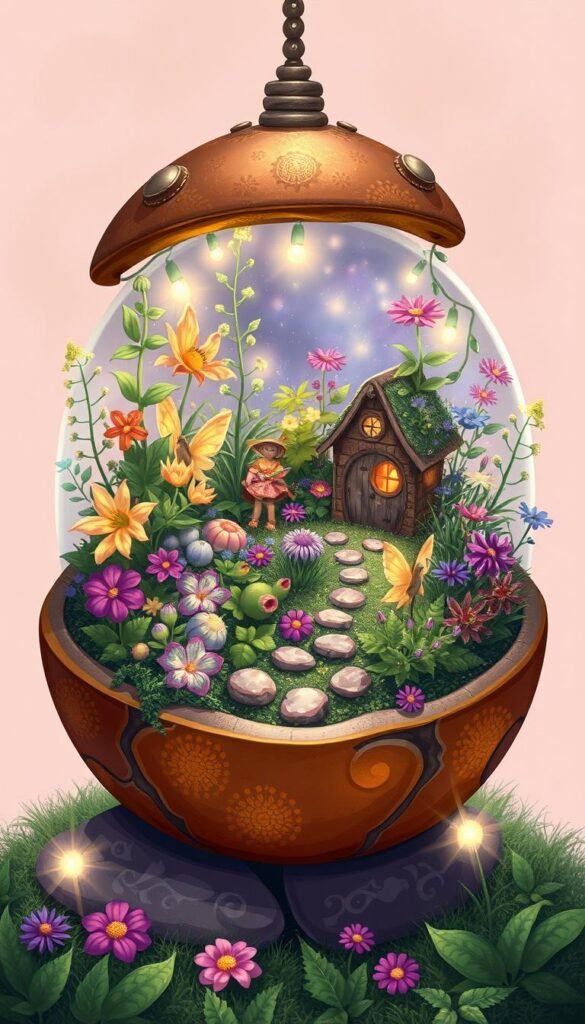
Your fairy garden’s container is the foundation upon which your miniature world is built. The possibilities are endless, from traditional pots to unconventional items that add character and charm.
Broken Pot Gardens
Broken pots can be repurposed into multi-level fairy gardens by using the larger broken piece as a middle wall and smaller pieces to fill gaps. River rocks can be stacked to fill larger gaps, creating a visually appealing landscape.
Teacup and Teapot Gardens
Teacups and teapots make charming containers for fairy gardens, adding a touch of vintage elegance. Ensure that you drill drainage holes to prevent waterlogged soil.
Repurposed Item Containers
Old toolboxes, vintage suitcases, wooden crates, and even old toys can be transformed into unique fairy garden containers. These items add a story and history to your display, making it even more captivating.
When selecting a container, consider the theme and style of your fairy garden. You can enhance repurposed containers with paint, decorative elements, or strategic weathering to complement your miniature world.
Maintaining Your Fairy Garden
The key to a stunning fairy garden lies in its upkeep and regular tending. To keep your miniature world thriving, it’s essential to understand the basics of maintenance.
Watering and Plant Care
Proper watering is crucial for your fairy garden. Since small pots dry out quickly, ensure that plants needing consistent moisture don’t go too long without water. Regular pruning is also necessary to keep plants small and manageable. Here are some tips for watering and plant care:
- Check the soil moisture regularly
- Water plants according to their needs
- Prune plants to maintain shape and size
Seasonal Refreshes
To keep your garden looking its best, consider seasonal refreshes. This can include changing plants, accessories, and design elements to match the current season. For example, you can add spring bulbs in March or festive decorations during the holiday season. Here are some ideas for seasonal refreshes:
- Spring: Add colorful bulbs and fresh flowers
- Summer: Incorporate vibrant decorations and lush greenery
- Autumn: Use fallen leaves and seasonal accessories
- Winter: Add fairy lights and snow-themed decorations
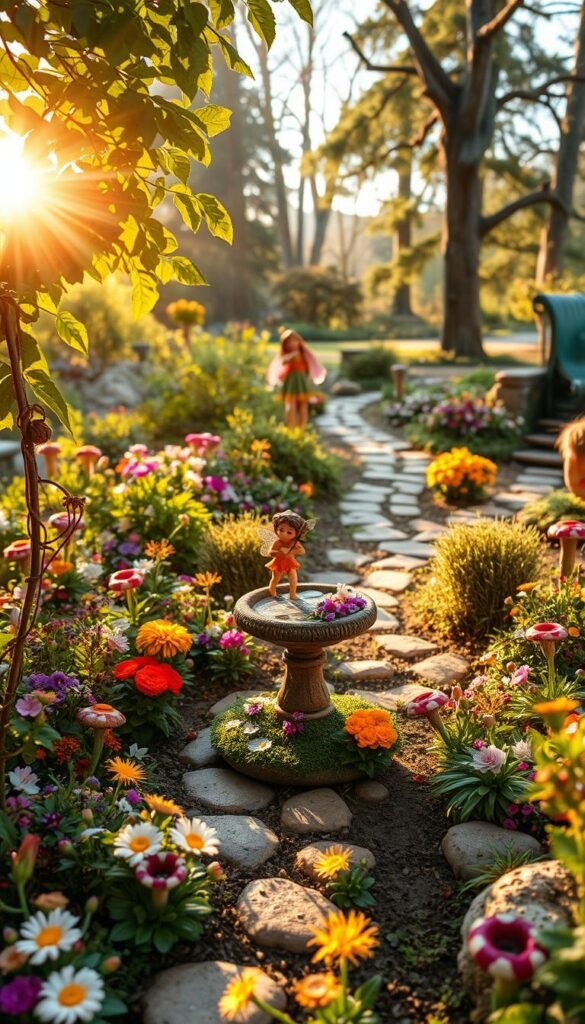
Fairy Garden Projects for Kids
Creating a fairy garden is a delightful way to engage kids with nature and encourage their creativity. This activity not only provides a fun outdoor experience but also offers numerous educational benefits.
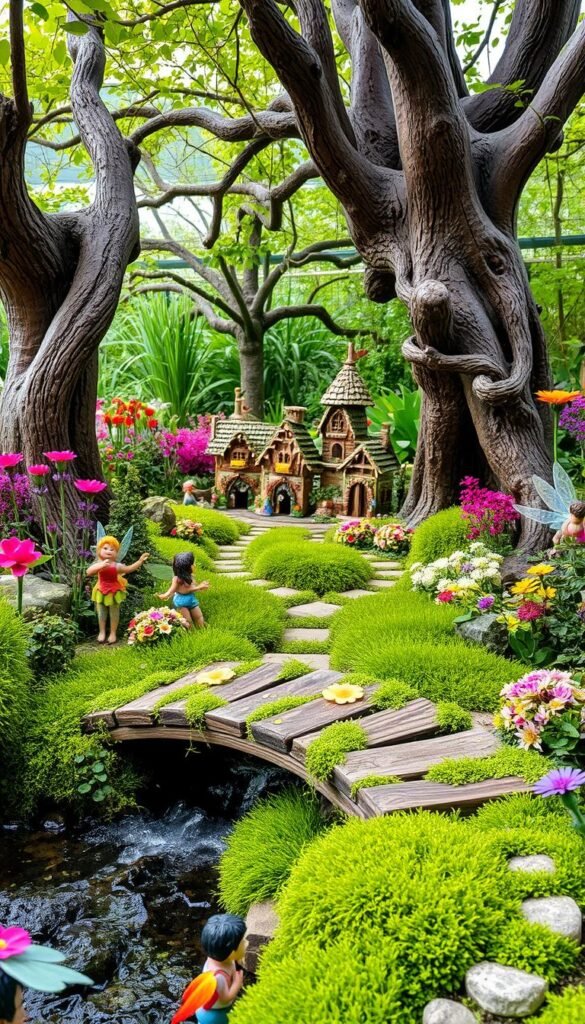
Age-Appropriate Activities
Kids can participate in various aspects of fairy garden creation, such as painting rocks with acrylic paints, selecting plants, and designing miniature landscapes. These activities help develop their fine motor skills and encourage imagination. For younger children, simple tasks like watering plants or arranging small stones can be both fun and educational.
Educational Benefits
Fairy gardening offers numerous educational benefits for children. It teaches them about plant care, life cycles, and environmental stewardship in an engaging way. By creating and maintaining a fairy garden, kids can learn about the importance of nurturing living things and develop a deeper appreciation for nature. Additionally, this activity encourages problem-solving, creative storytelling, and an understanding of ecosystems.
Troubleshooting Common Fairy Garden Problems
Fairy gardens, while enchanting, can be susceptible to various issues that need to be addressed. To keep your miniature world thriving, it’s essential to identify and resolve problems promptly.
Plant Issues
One of the most common challenges in maintaining a fairy garden is dealing with plant-related problems. Overwatering or underwatering can lead to unhealthy plants, while pests or diseases can cause damage. To mitigate these issues, ensure proper watering, use pest-resistant plants, and treat any infections promptly. Regularly inspecting your plants will help you catch any problems early.
Weather Damage Solutions
Weather conditions can significantly impact your fairy garden. Heavy rain, strong winds, or frost can damage plants, structures, and accessories. To protect your garden, consider using weather-resistant materials, securing loose items, and bringing sensitive elements indoors during extreme weather. You can also use protective coverings or strategic placement to minimize damage. For example, placing your fairy garden in a sheltered location can reduce the impact of harsh weather.
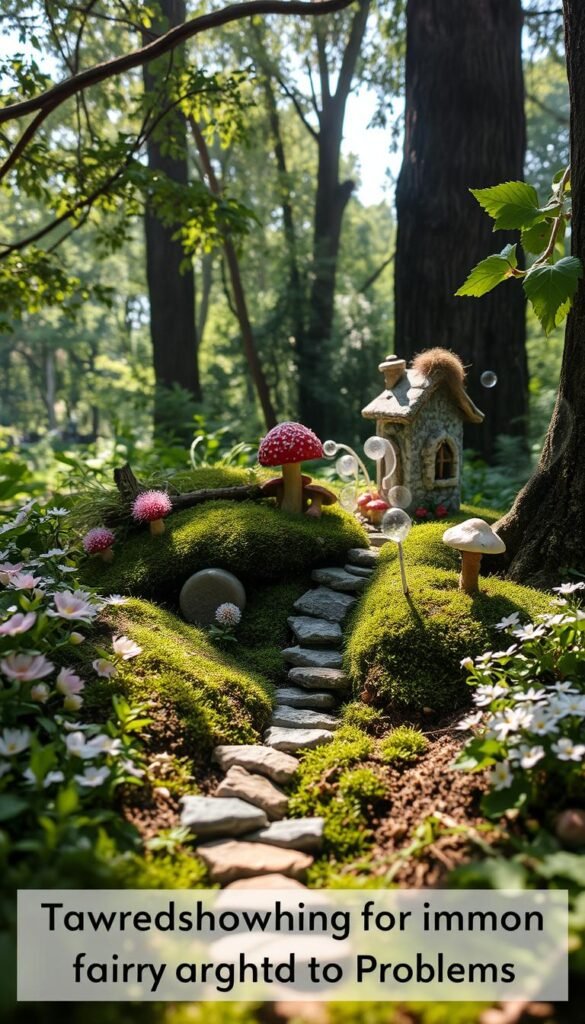
By being proactive and taking steps to prevent or repair damage, you can enjoy your fairy garden throughout the year. Regular maintenance and inspections will help you identify potential issues before they become major problems, ensuring your fairy garden remains a delightful and enchanting space.
Conclusion: Embracing the Enchantment of Your DIY Fairy Garden
Embracing the enchantment of your DIY fairy garden is just the beginning of a whimsical adventure. Throughout this guide, we’ve explored the essential elements of creating a captivating fairy garden, from selecting the right plants and materials to crafting miniature structures and accessories.
Your fairy garden is a reflection of your personal style and creativity. As you continue to nurture and evolve your garden, it will become a unique and meaningful part of your outdoor space, bringing joy to both you and your visitors.
The process of creating and maintaining a fairy garden is not just about aesthetics; it’s also a therapeutic and mindful hobby that allows you to connect with nature. Share your creation with others by hosting garden tours or simply sharing photos with friends and family.
Remember, there’s no “wrong way” to create a fairy garden. The most important thing is to have fun and let your imagination guide you. As you embark on this magical journey, you’ll discover the delight of crafting miniature worlds and the enchantment it brings to your everyday life.
